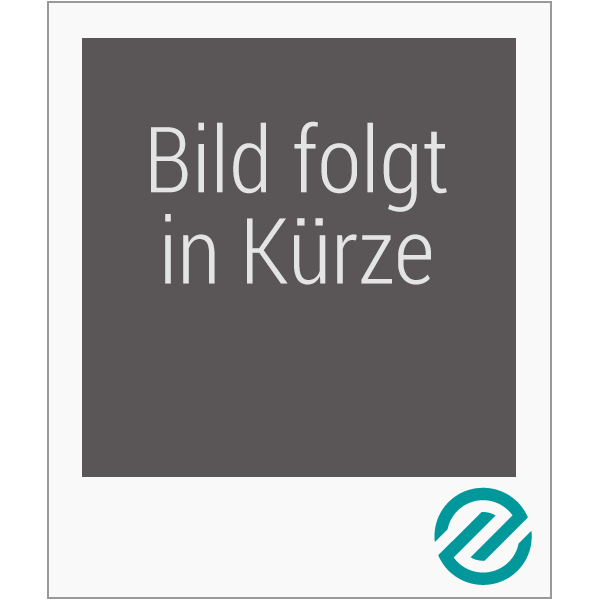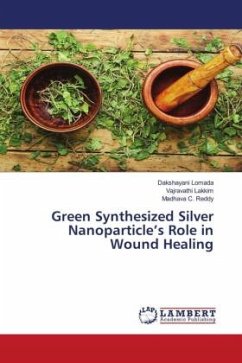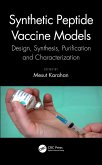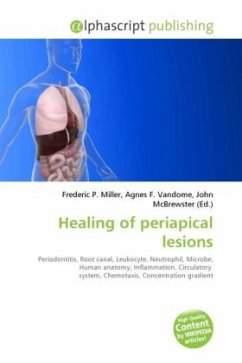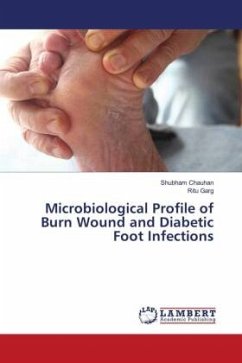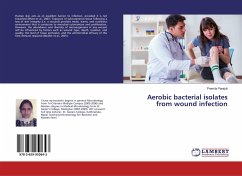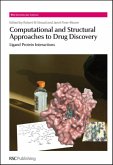Nanotechnology in Wound Healing
Innovations, Applications, and Future Perspectives
Herausgeber: Farid, Arshad; Ashique, Sumel; Ahmed, Mohammed Gulzar; Zengin, Gokhan
Nanotechnology in Wound Healing
Innovations, Applications, and Future Perspectives
Herausgeber: Farid, Arshad; Ashique, Sumel; Ahmed, Mohammed Gulzar; Zengin, Gokhan
- Gebundenes Buch
- Merkliste
- Auf die Merkliste
- Bewerten Bewerten
- Teilen
- Produkt teilen
- Produkterinnerung
- Produkterinnerung
This book reviews the role of engineered nanomaterials in wound healing, highlighting smart 3D printed hydrogels and drug-loaded nanomaterials. It also explores the role of the immune system and extracellular matrix in enhancing wound healing. This book is for researchers and students of biomedical engineering and nanotechnology.
Andere Kunden interessierten sich auch für
![Green Synthesized Silver Nanoparticle¿s Role in Wound Healing Green Synthesized Silver Nanoparticle¿s Role in Wound Healing]() Dakshayani LomadaGreen Synthesized Silver Nanoparticle¿s Role in Wound Healing47,99 €
Dakshayani LomadaGreen Synthesized Silver Nanoparticle¿s Role in Wound Healing47,99 €![Anti-infective and wound healing agents of plants sourced from Ghana Anti-infective and wound healing agents of plants sourced from Ghana]() Rita DicksonAnti-infective and wound healing agents of plants sourced from Ghana53,99 €
Rita DicksonAnti-infective and wound healing agents of plants sourced from Ghana53,99 €![Synthetic Peptide Vaccine Models Synthetic Peptide Vaccine Models]() Synthetic Peptide Vaccine Models174,99 €
Synthetic Peptide Vaccine Models174,99 €![Healing of periapical lesions Healing of periapical lesions]() Healing of periapical lesions31,99 €
Healing of periapical lesions31,99 €![Microbiological Profile of Burn Wound and Diabetic Foot Infections Microbiological Profile of Burn Wound and Diabetic Foot Infections]() Shubham ChauhanMicrobiological Profile of Burn Wound and Diabetic Foot Infections37,99 €
Shubham ChauhanMicrobiological Profile of Burn Wound and Diabetic Foot Infections37,99 €![Aerobic bacterial isolates from wound infection Aerobic bacterial isolates from wound infection]() Pramila ParajuliAerobic bacterial isolates from wound infection37,99 €
Pramila ParajuliAerobic bacterial isolates from wound infection37,99 €![Computational and Structural Approaches to Drug Discovery Computational and Structural Approaches to Drug Discovery]() Computational and Structural Approaches to Drug Discovery212,99 €
Computational and Structural Approaches to Drug Discovery212,99 €-
-
-
This book reviews the role of engineered nanomaterials in wound healing, highlighting smart 3D printed hydrogels and drug-loaded nanomaterials. It also explores the role of the immune system and extracellular matrix in enhancing wound healing. This book is for researchers and students of biomedical engineering and nanotechnology.
Hinweis: Dieser Artikel kann nur an eine deutsche Lieferadresse ausgeliefert werden.
Hinweis: Dieser Artikel kann nur an eine deutsche Lieferadresse ausgeliefert werden.
Produktdetails
- Produktdetails
- Verlag: Taylor & Francis Ltd
- Seitenzahl: 336
- Erscheinungstermin: 28. Mai 2025
- Englisch
- Abmessung: 254mm x 178mm
- Gewicht: 453g
- ISBN-13: 9781032997735
- ISBN-10: 1032997737
- Artikelnr.: 72211661
- Herstellerkennzeichnung
- Libri GmbH
- Europaallee 1
- 36244 Bad Hersfeld
- gpsr@libri.de
- Verlag: Taylor & Francis Ltd
- Seitenzahl: 336
- Erscheinungstermin: 28. Mai 2025
- Englisch
- Abmessung: 254mm x 178mm
- Gewicht: 453g
- ISBN-13: 9781032997735
- ISBN-10: 1032997737
- Artikelnr.: 72211661
- Herstellerkennzeichnung
- Libri GmbH
- Europaallee 1
- 36244 Bad Hersfeld
- gpsr@libri.de
Dr. Mohammed Gulzar Ahmed serves as the Principal & Dean at Yenepoya Pharmacy College & Research Centre, part of Yenepoya (deemed to be a university), located in Mangalore, Karnataka, India. With a career that spans over 22 years in teaching and an additional 3 years dedicated to research, he has made significant contributions to the field. His scholarly output includes more than 150 publications in internationally and nationally accredited journals. His expertise encompasses novel drug delivery systems, nanotechnology, targeted drug delivery, and stability studies. Dr. Ahmed has secured 7 patents and has authored 3 book chapters and 4 books. He has also obtained a DST-SERB CRG grant, along with several seed grants from Yenepoya and RGUHS Universities. He has been recognized by the university with awards for Best Researcher, Best Paper, and Good Teacher. Dr. Sumel Ashique currently holds the position of Assistant Professor in the Department of Pharmaceutical Sciences at Bengal College of Pharmaceutical Sciences & Research in Durgapur, West Bengal, India. He brings 3 years of teaching experience to his role. His academic contributions include over 60 publications in both international and national journals of repute. His areas of expertise are in drug delivery, nanotechnology, and targeted treatment strategies. He has been awarded 4 patents from IP Australia and has published 6 book chapters in international books. Additionally, he has published 15 book chapters and edited 5 books with international publishers. Dr. Arshad Farid has been serving as an Assistant Professor at the Gomal Center of Biochemistry and Biotechnology, Gomal University, D.I.Khan, Pakistan, since April 2014. With approximately sixteen years of combined teaching and research experience, he has published more than 90 research articles in journals of international and national repute. His research is markedly interdisciplinary, covering areas such as Medicinal Plants, Natural Product Chemistry, Herbal Drug Development, Ethnopharmacology, Nanotechnology, Drug Delivery, and Microbiology. He has contributed more than 20 book chapters and holds 15 international patents from countries including Germany, the UK, and South Africa. Additionally, he has presented over 15 abstracts at national and international conferences. Dr. Farid actively contributes to the scientific community through peer review of papers for more than 20 respected journals. He was a fellow of the British Council-Charles Wallace Fellowship program at the University of Aberdeen, Scotland, UK, in 2023, and previously received a fellowship in 2007 for training in Environmental, Agricultural, and Analytical Chemistry Laboratory Techniques at the Department of Chemistry, University of Glasgow, Scotland, UK. He is also a Research Fellow at INTI International University, Malaysia, from June 1, 2023, to December 31, 2025. Dr. Zengin is an alumnus of Selcuk University's Faculty of Science in Turkey, where he also earned his Ph.D. from the Natural and Applied Sciences Institute's Department of Biology. Presently, he holds a professorship at Selcuk University within the same faculty and department. His research focuses on biological activity, chromatographic techniques, and enzyme inhibition. Dr. Zengin has contributed 800 publications to his field of research, amassed over 18,000 citations, and delivered numerous presentations at scientific congresses.
Chapter 1: Engineered Nanomaterials for Wound Healing. Chapter 2:
Nanocellulose: Advanced Application in Wound Healing. Chapter 3:
Advancements in Nanomaterial-Based Drug Delivery Systems for Wound Healing.
Chapter 4: Artificial Intelligence for Wound Healing (Real-Time Monitoring,
Image-Based, Bioinformatics, and Precision Regulation). Chapter 5: Role of
the Immune System in Wound Healing and Strategies to Modulate Immune
Responses to Promote Wound Healing. Chapter 6: The Role of the
Extracellular Matrix (ECM) in Wound Healing (Matrix Metalloproteinases,
Growth Factors). Chapter 7: Tissue Engineering for Wound Healing: Recent
Advancements and Opportunities. Chapter 8: Nanomaterials in Wound Healing:
Mechanism, Recent Advancements, Limitations, and Future Perspectives.
Chapter 9: Toxicity Study of Nanomaterials in Wound Healing Purposes.
Chapter 10: The Emergence of High-Tech Tools in Topical Dermal Drug
Delivery: 3D and 4D Printing. Chapter 11: Polymeric Nanomaterials in Wound
Healing and Tissue Remodeling. Chapter 12: Application of Green Synthesized
Nanomaterials for Wound Healing and Cell Growth Stimulation.
Nanocellulose: Advanced Application in Wound Healing. Chapter 3:
Advancements in Nanomaterial-Based Drug Delivery Systems for Wound Healing.
Chapter 4: Artificial Intelligence for Wound Healing (Real-Time Monitoring,
Image-Based, Bioinformatics, and Precision Regulation). Chapter 5: Role of
the Immune System in Wound Healing and Strategies to Modulate Immune
Responses to Promote Wound Healing. Chapter 6: The Role of the
Extracellular Matrix (ECM) in Wound Healing (Matrix Metalloproteinases,
Growth Factors). Chapter 7: Tissue Engineering for Wound Healing: Recent
Advancements and Opportunities. Chapter 8: Nanomaterials in Wound Healing:
Mechanism, Recent Advancements, Limitations, and Future Perspectives.
Chapter 9: Toxicity Study of Nanomaterials in Wound Healing Purposes.
Chapter 10: The Emergence of High-Tech Tools in Topical Dermal Drug
Delivery: 3D and 4D Printing. Chapter 11: Polymeric Nanomaterials in Wound
Healing and Tissue Remodeling. Chapter 12: Application of Green Synthesized
Nanomaterials for Wound Healing and Cell Growth Stimulation.
Chapter 1: Engineered Nanomaterials for Wound Healing. Chapter 2:
Nanocellulose: Advanced Application in Wound Healing. Chapter 3:
Advancements in Nanomaterial-Based Drug Delivery Systems for Wound Healing.
Chapter 4: Artificial Intelligence for Wound Healing (Real-Time Monitoring,
Image-Based, Bioinformatics, and Precision Regulation). Chapter 5: Role of
the Immune System in Wound Healing and Strategies to Modulate Immune
Responses to Promote Wound Healing. Chapter 6: The Role of the
Extracellular Matrix (ECM) in Wound Healing (Matrix Metalloproteinases,
Growth Factors). Chapter 7: Tissue Engineering for Wound Healing: Recent
Advancements and Opportunities. Chapter 8: Nanomaterials in Wound Healing:
Mechanism, Recent Advancements, Limitations, and Future Perspectives.
Chapter 9: Toxicity Study of Nanomaterials in Wound Healing Purposes.
Chapter 10: The Emergence of High-Tech Tools in Topical Dermal Drug
Delivery: 3D and 4D Printing. Chapter 11: Polymeric Nanomaterials in Wound
Healing and Tissue Remodeling. Chapter 12: Application of Green Synthesized
Nanomaterials for Wound Healing and Cell Growth Stimulation.
Nanocellulose: Advanced Application in Wound Healing. Chapter 3:
Advancements in Nanomaterial-Based Drug Delivery Systems for Wound Healing.
Chapter 4: Artificial Intelligence for Wound Healing (Real-Time Monitoring,
Image-Based, Bioinformatics, and Precision Regulation). Chapter 5: Role of
the Immune System in Wound Healing and Strategies to Modulate Immune
Responses to Promote Wound Healing. Chapter 6: The Role of the
Extracellular Matrix (ECM) in Wound Healing (Matrix Metalloproteinases,
Growth Factors). Chapter 7: Tissue Engineering for Wound Healing: Recent
Advancements and Opportunities. Chapter 8: Nanomaterials in Wound Healing:
Mechanism, Recent Advancements, Limitations, and Future Perspectives.
Chapter 9: Toxicity Study of Nanomaterials in Wound Healing Purposes.
Chapter 10: The Emergence of High-Tech Tools in Topical Dermal Drug
Delivery: 3D and 4D Printing. Chapter 11: Polymeric Nanomaterials in Wound
Healing and Tissue Remodeling. Chapter 12: Application of Green Synthesized
Nanomaterials for Wound Healing and Cell Growth Stimulation.

